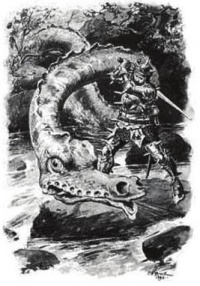Difference between revisions of "Chapter 60: 585-596"
Greenlantern (Talk | contribs) m (→Page 587) |
Greenlantern (Talk | contribs) (→Page 588) |
||
| Line 21: | Line 21: | ||
==Page 588== | ==Page 588== | ||
'''John Lambton'''<br>[[File:Lambtonworm.jpg|200px|thumb|right|Illustration of John Lambton battling the Worm]]The story revolves around John Lambton, an heir of the Lambton Estate, County Durham, and his battle with a giant worm which had been terrorising the local villages. As with most myths, details of the story change with each telling. From [http://en.wikipedia.org/wiki/Lambton_Worm WIKI] | '''John Lambton'''<br>[[File:Lambtonworm.jpg|200px|thumb|right|Illustration of John Lambton battling the Worm]]The story revolves around John Lambton, an heir of the Lambton Estate, County Durham, and his battle with a giant worm which had been terrorising the local villages. As with most myths, details of the story change with each telling. From [http://en.wikipedia.org/wiki/Lambton_Worm WIKI] | ||
| + | |||
| + | '''Lamprey'''<br> | ||
| + | A lamprey (sometimes also called lamprey eel) is a parasitic marine animal with a toothed, funnel-like sucking mouth. Translated directly, their name means stone lickers (lambere = to lick, and petra = stone). While lampreys are well known for those species which bore into the flesh of other fish to suck their blood, these species make up the minority. In zoology, lampreys are often not considered to be true fish because of their vastly different morphology and physiology. From [http://en.wikipedia.org/wiki/Lamprey WIKI] | ||
==Page 591== | ==Page 591== | ||
Revision as of 11:28, 22 October 2009
Page 585
"Sandwich"
See pages 366 & 367.
Page 586
Quit-Rent
See page 359.
Page 587
Draco, the DragonLambton Worm
The Lambton Worm is a legend from the North East of England in the UK. The story is one of the area's most famous pieces of folklore, having been adapted from written and oral tradition into pantomime and song formats. From WIKI
Lambton Castle
Lambton Castle, located in County Durham, England, between the towns of Washington and Chester-le-Street, is a stately home, the ancestral seat of the Lambton family, the Earls of Durham. From WIKI
Cockfield
Cockfield is a village on the edge of Teesdale, County Durham, in England. It is situated a few miles to the south-west of Bishop Auckland. Remains found on Cockfield Fell suggest there was a settlement in the area in the Iron Age. The parish church, dedicated to St Mary the Virgin, probably dates from the late 12th century. Coal mining began in the area in the medieval period. From WIKI Also, see page 504.
Page 588
John LambtonThe story revolves around John Lambton, an heir of the Lambton Estate, County Durham, and his battle with a giant worm which had been terrorising the local villages. As with most myths, details of the story change with each telling. From WIKI
Lamprey
A lamprey (sometimes also called lamprey eel) is a parasitic marine animal with a toothed, funnel-like sucking mouth. Translated directly, their name means stone lickers (lambere = to lick, and petra = stone). While lampreys are well known for those species which bore into the flesh of other fish to suck their blood, these species make up the minority. In zoology, lampreys are often not considered to be true fish because of their vastly different morphology and physiology. From WIKI
Page 591
if God should allow him victory over the Worm, he would sacrifice unto Him the first living thing he then happen'd to see
Biblical allusion. In Judges 11, Jephthah vowes to sacrifice whoever first comes into his house, should God grant him victory over the Ammonites. It is actually Jephthah's daughter, and the sacrifice is accomplished. Interpretations disagree though on whether "sacrifice" has to be taken literally.

